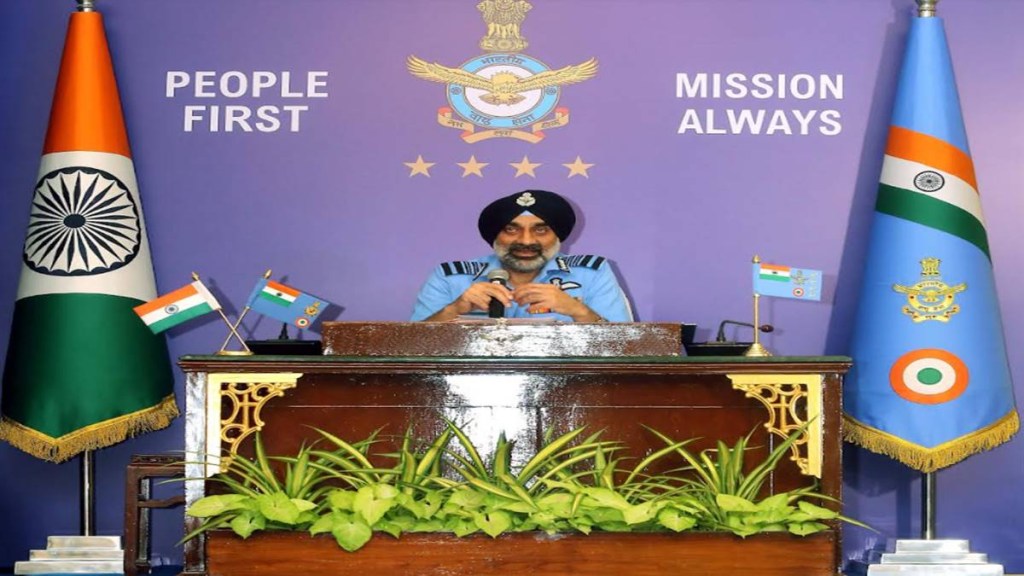India’s drive toward self-reliance has taken a pivotal role in the Indian Air Force‘s (IAF) future plans. Faced with the dual challenge of securing its borders and reducing dependency on foreign defence systems, the IAF aims to have its entire fleet produced domestically by 2047.
Responding to media queries ahead of the Air Force day on Oct 8, Chief of the Indian Air Force Air Chief Marshal AP Singh, highlighted the urgency of this shift, particularly in light of growing tensions with China along the Line of Actual Control (LAC).
Strengthening Border Infrastructure Amid China’s Expansion
A key concern for India is China’s rapid infrastructure development along the LAC, particularly in the Ladakh sector. Over recent years, China has constructed roads, air bases, and logistical hubs near the disputed border, enhancing its military capabilities in the region. “We are also upgrading our infrastructure,” Singh noted, highlighting that India is working hard to match China’s pace. However, the long-term answer to this challenge lies in bolstering indigenous defence capabilities.
Indigenous Systems for Future Security
The push for homegrown defence technologies is not just about modernization; it’s about future readiness. Singh stressed that indigenous weapons systems are critical to meeting emerging security challenges. “It is important to have our own systems in place to deal with any threats,” he remarked, alluding to the geopolitical tensions and conflicts that could arise.
The IAF is already moving in that direction. While three units of the S-400 missile system have been delivered by Russia, with two more expected next year, Singh envisions a future where foreign dependencies are minimized. According to him the transition will not happen overnight, but the goal is to make the Indian defence sector self-sufficient in the long term.
Addressing Delays and Private Sector Involvement
A significant hurdle in the path toward self-reliance has been delays in the production of the Light Combat Aircraft (LCA) Tejas. Hindustan Aeronautics Limited (HAL), the state-run manufacturer, has struggled to meet delivery deadlines, partly due to internal challenges and delays in acquiring key components like GE-F404 aero-engines from the United States. “It is a known fact that the Tejas aircraft has been delayed,” Singh admitted. “We need to look at private players coming in to help meet the production challenges.”
Singh highlighted the need for HAL to overcome its limitations and for private industry to step up. With plans to induct nearly 300 Tejas Mark-1A and Mark-2 fighters over the next 10-15 years, ramping up production is crucial for maintaining the IAF’s operational readiness.
For this goal to be achieved collaboration with private industries is a necessary step in ensuring timely delivery and expanding production capabilities.
Aiming for Full Domestic Production by 2047
One of the most ambitious goals laid out by Singh is the plan to have the entire IAF inventory produced domestically by 2047. This milestone year, coinciding with India’s centenary of independence, symbolizes the country’s broader vision of self-reliance in critical sectors. “We have to take decisions quickly, and the aircraft should be made in India,” Singh emphasized.
The shift to domestic production isn’t just about reducing reliance on imports—it’s about ensuring that India’s defence sector can adapt to rapidly changing technological landscapes.
Status of the Medium Transport Aircraft
According to the chief the aging fleet of AN 32 and IL 76 need to be replaced. “These we will go for a common aircraft and a RfI (Request for Information) has already been issued. No decision has been taken yet.”
Space Based Systems
For the IAF, this means integrating cutting-edge air and space technologies into its operations. Singh mentioned ongoing collaborations with ISRO and other agencies to enhance the country’s space-based assets, which are critical for future warfare scenarios where space and air domains intersect.
Facing Future Conflicts with a Stronger, Self-Sufficient Fleet
As geopolitical tensions simmer across various fronts, from the LAC with China to maritime challenges in the Indo-Pacific, India’s need for a robust, homegrown defence capability has never been greater. While the current infrastructure along the LAC is being strengthened, the long-term answer lies in having a fleet that is not only powerful but also self-sustained. “We will need large numbers,” Singh said, referring to the IAF’s readiness to match advanced defence systems like Israel’s Iron Dome. However, he stressed the importance of prioritization—India cannot defend every corner of its vast territory without strategic planning.
The IAF’s focus is clear: ensuring it has the necessary assets to maintain operational readiness, from missile defence systems to advanced aircraft, all produced domestically. This will allow India to navigate an increasingly complex security environment with confidence, no longer hampered by delays or dependencies on foreign suppliers.
The Path Forward: Innovation and Rapid Decision-Making
The future of the IAF hinges on rapid decision-making and a commitment to innovation. As Singh pointed out, there’s no time for delays in building up India’s defence capabilities. “We have to make decisions quickly,” he remarked, urging policymakers and industry leaders to expedite efforts toward achieving the 2047 goal.

